Joe Sacco’s Palestine is a groundbreaking graphic novel blending journalism and storytelling‚ offering a poignant account of Palestinian life under occupation‚ now widely accessible in PDF format.
1.1. Background of Joe Sacco and His Work
Joe Sacco is a renowned cartoonist and journalist‚ celebrated for his innovative approach to graphic journalism. Born in Malta in 1960‚ he later moved to Australia and the U.S.‚ where he developed a passion for storytelling and social justice. His early work often involved travel journalism‚ but he gained international acclaim for his focus on conflict zones‚ particularly Palestine. Sacco’s unique style combines meticulous research with vivid visuals‚ making complex issues accessible. His notable works include Palestine‚ Footnotes in Gaza‚ and Safe Area Goražde‚ solidifying his reputation as a pioneer in the field.
1.2. Overview of the Graphic Novel “Palestine”
Palestine is a graphic novel by Joe Sacco that captures the lives of Palestinians during the First Intifada. Through vivid illustrations and personal narratives‚ Sacco documents the human cost of occupation‚ offering a raw and unfiltered perspective. The book combines journalism and storytelling‚ presenting the struggles of displacement‚ daily hardships‚ and the emotional toll of conflict. Sacco’s work is both a historical record and a deeply personal account‚ making it a powerful and thought-provoking read. Its availability in PDF format has made it more accessible‚ ensuring its message reaches a wider audience.
1.3. The Significance of the PDF Format in Disseminating the Work
The PDF format of Palestine has played a crucial role in its widespread dissemination. PDFs are easily shareable and accessible across devices‚ making the graphic novel reachable to a global audience. This format ensures that Sacco’s vivid illustrations and detailed narratives remain intact‚ preserving the book’s visual and emotional impact. The accessibility of the PDF version has also facilitated academic and critical discussions‚ allowing scholars and readers to engage with the work in various settings. This digital availability has been instrumental in keeping the story of Palestine relevant and widely read.
Key Themes Explored in “Palestine”
The graphic novel delves into the Israeli-Palestinian conflict‚ human suffering‚ and the role of journalism‚ while exploring themes of identity‚ displacement‚ and the struggle for justice.
2.1. The Israeli-Palestinian Conflict
Joe Sacco’s “Palestine” vividly portrays the Israeli-Palestinian conflict‚ highlighting its historical roots and contemporary tensions. Through detailed illustrations and personal narratives‚ Sacco captures the complexities of the occupation‚ emphasizing the disparities in power and lived experiences. The graphic novel sheds light on the daily struggles of Palestinians under Israeli rule‚ offering a human-centric perspective that challenges simplistic narratives. Sacco’s work bridges history and immediacy‚ illustrating how the conflict shapes identities and fuels resilience among those affected.
2.2. The Human Cost of War and Occupation
Joe Sacco’s “Palestine” underscores the profound human cost of war and occupation‚ illustrating the physical and emotional toll on civilians. The graphic novel depicts displacement‚ violence‚ and loss‚ emphasizing how these experiences shape daily life. Sacco’s detailed illustrations and personal testimonies highlight the psychological trauma and resilience of Palestinians living under occupation. By focusing on individual stories‚ the work humanizes the conflict‚ revealing the devastating impact on families‚ communities‚ and identity. This approach creates a visceral connection‚ making the realities of occupation relatable and unforgettable.
2.3. The Role of Journalism in Conflict Zones
Joe Sacco’s “Palestine” highlights the critical role of journalism in conflict zones‚ blending reportage with storytelling. Sacco’s graphic journalism provides a unique lens‚ capturing the complexities of the Israeli-Palestinian conflict. His work emphasizes the importance of firsthand accounts‚ offering a platform for marginalized voices. By immersing himself in the environment‚ Sacco ensures authenticity‚ balancing objectivity with empathy. This approach underscores the challenges and responsibilities of journalists in conveying the truth amidst conflict‚ making “Palestine” a seminal work in graphic journalism.
2.4. The Concept of Citizenship and Belonging
Joe Sacco’s “Palestine” explores the intricate themes of citizenship and belonging‚ particularly for Palestinians living under occupation. The graphic novel delves into the struggles of statelessness and the fragmented identities of those denied formal citizenship. Sacco portrays the emotional toll of displacement‚ highlighting how historical events‚ such as the 1948 Nakba‚ have shaped the Palestinian experience. Through personal narratives‚ he underscores the resilience of cultural identity despite the absence of legal recognition‚ offering a poignant reflection on belonging in a contested land.
Narrative Style and Structure
Joe Sacco’s “Palestine” employs an innovative narrative style‚ blending personal encounters with political context‚ creating a visually immersive and emotionally impactful account of life under occupation.
3.1. Sacco’s Unique Approach to Graphic Journalism
Joe Sacco’s “Palestine” showcases his pioneering approach to graphic journalism‚ blending meticulous research with vivid‚ hand-drawn visuals. His immersive storytelling captures the human dimension of conflict‚ offering an intimate and unflinching portrayal of life under occupation. Sacco’s unique style combines detailed illustrations with candid testimonies‚ creating a compelling narrative that bridges art and journalism. His commitment to authenticity and emotional depth sets a new standard for documenting war and its impact on civilians‚ making “Palestine” a landmark work in the genre.
3.2. The Use of Visual Storytelling in “Palestine”
Joe Sacco’s “Palestine” employs visual storytelling to convey the complexities of life under occupation. Through detailed‚ hand-drawn illustrations‚ Sacco captures the environment‚ emotions‚ and experiences of Palestinians. His art style‚ often stark and unflinching‚ adds authenticity to the narrative; The visuals complement the text‚ creating a powerful synergy that immerses readers in the story. Sacco’s ability to balance imagery with written accounts enhances the emotional impact‚ making the graphic novel a compelling and accessible medium for understanding the Palestinian experience.
3.3. The Intersection of Personal and Political Narratives

In “Palestine‚” Joe Sacco masterfully intertwines personal stories with broader political themes. By focusing on individual experiences‚ he humanizes the Israeli-Palestinian conflict‚ making it relatable and emotionally resonant. The personal narratives of Palestinians‚ shared through their testimonies‚ are woven into the larger political context of occupation and resistance. This blend creates a nuanced exploration of how political realities shape personal lives‚ offering readers a deeper understanding of the conflict’s human dimension and its enduring impact on everyday people.
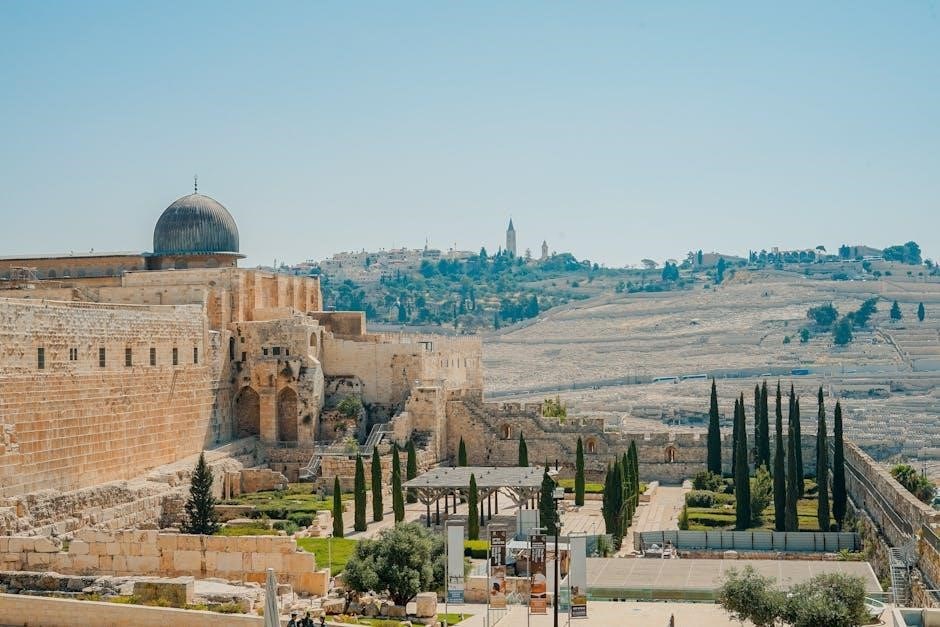
Historical Context of the Israeli-Palestinian Conflict
The Israeli-Palestinian conflict traces back to the 1948 Arab-Israeli War‚ leading to Palestinian displacement and ongoing occupation. Sacco’s work highlights the roots of this enduring struggle.
4.1. A Brief History of the Conflict
The Israeli-Palestinian conflict began with the 1948 Arab-Israeli War‚ leading to the displacement of hundreds of thousands of Palestinians‚ known as the Nakba or “catastrophe.” The 1967 Six-Day War further expanded Israeli control over Palestinian territories. Sacco’s Palestine highlights the ongoing occupation‚ settler expansion‚ and the daily struggles of Palestinians under military rule. The First Intifada (1987–1993) marked a turning point in resistance‚ while the Oslo Accords (1993) promised peace but failed to deliver‚ leaving the conflict unresolved and tensions escalating to this day.
4.2. The First Intifada and Its Impact on Palestinians
The First Intifada (1987–1993) was a mass uprising of Palestinians against Israeli occupation‚ marked by protests‚ strikes‚ and stone-throwing. It shifted the conflict from armed resistance to grassroots mobilization‚ uniting Palestinians across the West Bank and Gaza. The intifada amplified global awareness of Palestinian struggles‚ leading to international pressure on Israel. However‚ it also resulted in heavy casualties‚ mass arrests‚ and economic hardship for Palestinians. The intifada weakened the PLO’s leadership and paved the way for Hamas’s rise‚ reshaping the political landscape of the conflict.
4.3. The Role of International Politics in the Conflict
International politics significantly influences the Israeli-Palestinian conflict‚ with global powers shaping its dynamics. The U.S. and Israel maintain a strong alliance‚ while countries like Russia and Iran support opposing factions. The U.N. and E.U. advocate for a two-state solution‚ but geopolitical interests often hinder progress. Regional actors‚ such as Arab League nations‚ play roles that reflect their own agendas. This complex web of alliances and rivalries exacerbates tensions‚ making a resolution challenging. Joe Sacco’s work highlights how external interventions impact Palestinian daily life and autonomy‚ amplifying the conflict’s global dimensions.
The Role of Refugees and Displacement
Palestinian displacement is a central focus in Joe Sacco’s work‚ highlighting the history‚ living conditions‚ and human stories of refugees caught in a protracted crisis.
5.1. The Jabalia Refugee Camp Depiction
Joe Sacco vividly captures the harsh realities of life in the Jabalia Refugee Camp‚ one of Gaza’s most densely populated and impoverished areas. His illustrations convey the cramped living conditions‚ makeshift shelters‚ and the resilience of residents. Through detailed visuals and personal testimonies‚ Sacco humanizes the experiences of refugees‚ emphasizing their daily struggles and the psychological toll of displacement. The camp’s depiction serves as a microcosm of the broader Palestinian refugee crisis‚ highlighting the enduring impact of displacement on individuals and families.
5.2. The Psychological and Social Impact of Displacement
Joe Sacco’s “Palestine” delves into the profound psychological and social effects of displacement on Palestinians. The loss of homeland and identity fosters trauma‚ anxiety‚ and hopelessness. Social structures are strained as families are separated and communities fragmented. Sacco illustrates how displacement erodes cultural heritage and perpetuates cycles of poverty and marginalization. The collective trauma resonates across generations‚ shaping individual and communal resilience. His work underscores the emotional toll of living in limbo‚ where uncertainty and injustice define daily life.
5.3. The Struggle for Identity Among Palestinian Refugees
In “Palestine‚” Joe Sacco examines how displacement disrupts Palestinian refugees’ sense of identity. Living in exile‚ they grapple with preserving their cultural heritage and connection to a homeland they may never return to. The loss of statehood and the experience of statelessness exacerbate feelings of alienation. Sacco highlights the intergenerational struggle‚ as younger generations balance their Palestinian roots with life in diaspora. This duality fosters a complex identity‚ blending resilience with a deep longing for belonging. Sacco’s narratives illustrate how refugees cling to their history‚ even as they navigate unfamiliar worlds.

The Reception and Impact of “Palestine”
Joe Sacco’s “Palestine” received widespread acclaim for its unflinching portrayal of life under occupation. It has been praised for its emotional depth and journalistic integrity‚ earning critical recognition and sparking essential conversations about the Israeli-Palestinian conflict. The work has influenced both graphic journalism and political discourse‚ solidifying its place as a seminal text in the genre. Its impact extends beyond academia‚ resonating with readers worldwide and inspiring further exploration of conflict narratives.
6.1. Critical Reception and Academic Analysis
Joe Sacco’s Palestine has garnered widespread critical acclaim for its raw‚ unfiltered portrayal of life under occupation. Scholars and critics praise its innovative storytelling‚ blending journalism with graphic narrative. The work is celebrated for its ability to humanize the Palestinian experience‚ offering a counter-narrative to mainstream media. Academic analysis highlights its thematic depth‚ exploring themes of displacement‚ resistance‚ and identity. The book is often cited as a landmark in graphic journalism‚ earning Sacco recognition as a pioneer in the field. Its impact on both cultural discourse and academic study remains significant.
6.2; The Book’s Contribution to Graphic Journalism
Palestine has redefined graphic journalism‚ setting a new standard for storytelling in the medium. Sacco’s meticulous research and immersive approach provide unparalleled authenticity‚ blending personal narratives with broader political contexts. The book’s innovative use of visuals and text has inspired countless creators‚ solidifying its status as a foundational work in the genre. By bridging journalism and comics‚ Sacco has expanded the possibilities of graphic storytelling‚ making it a powerful tool for documenting human rights issues and social injustices. Its influence continues to shape contemporary graphic journalism.
6.3. The Cultural and Political Impact of the Work
Palestine has had a profound cultural and political impact‚ challenging perceptions about the Israeli-Palestinian conflict. It has sparked global conversations‚ inspiring debates about justice‚ rights‚ and representation. The book has influenced art‚ activism‚ and academia‚ becoming a cornerstone of contemporary political discourse. By amplifying Palestinian voices‚ Sacco’s work has humanized a conflict often reduced to headlines‚ fostering empathy and understanding. Its influence extends beyond literature‚ shaping public opinion and encouraging solidarity with marginalized communities‚ making it a vital tool for advocacy and education.
Comparative Analysis with Other Works by Joe Sacco
Joe Sacco’s Palestine shares thematic and stylistic similarities with his other works‚ such as Footnotes in Gaza and Safe Area Goražde‚ exploring conflict‚ human toll‚ and journalistic integrity through visceral‚ detailed visuals and personal narratives.
7.1. “Footnotes in Gaza” and Its Connection to “Palestine”
Footnotes in Gaza complements Palestine by delving into the 1956 invasion of Gaza‚ while Palestine focuses on the First Intifada. Both works highlight Sacco’s commitment to documenting Palestinian struggles‚ blending historical context with personal testimonies. The graphic narratives share a similar visual and thematic style‚ emphasizing the human cost of conflict. Together‚ they provide a comprehensive understanding of the Israeli-Palestinian conflict’s enduring impact‚ showcasing Sacco’s ability to weave historical events with individual experiences seamlessly.
7.2. “Safe Area Goražde” and Its Relevance to Conflict Reporting
Safe Area Goražde is a graphic novel by Joe Sacco that documents the Bosnian War‚ focusing on the besieged enclave of Goražde. While distinct from Palestine‚ it shares Sacco’s immersive approach to conflict reporting. Both works use detailed visuals and personal narratives to humanize war’s impact. Safe Area Goražde highlights Sacco’s ability to capture the complexities of conflict‚ making it a seminal work in graphic journalism. Its raw‚ unfiltered storytelling aligns with the same journalistic integrity seen in Palestine.
7.3. The Evolution of Sacco’s Style and Themes
Joe Sacco’s style and themes have evolved significantly over his career‚ with Palestine marking a pivotal moment in his development as a graphic journalist. His earlier works‚ like Footnotes in Gaza‚ showcased his meticulous research and storytelling‚ while Palestine refined his ability to blend personal narratives with political contexts. Sacco’s art became more detailed and expressive‚ enhancing the emotional impact of his stories. This evolution solidified his reputation as a master of graphic journalism‚ capable of conveying complex conflicts with depth and humanity.
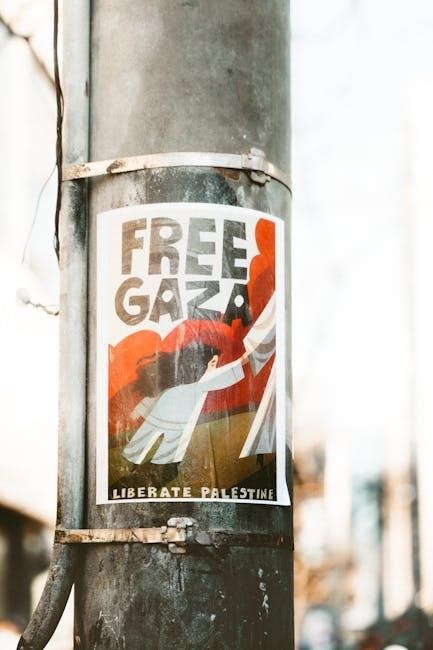
The Role of Trauma and Memory in the Narrative
Joe Sacco’s Palestine vividly portrays trauma and memory through personal stories‚ illustrating the lasting emotional scars of conflict on individuals and communities‚ enriching the narrative’s human depth.
8.1. The Representation of Trauma in “Palestine”
Joe Sacco’s Palestine masterfully represents trauma through vivid‚ unflinching visuals and personal testimonies. His graphic narrative captures the psychological toll of violence and displacement‚ conveying the enduring pain of individuals. Sacco’s detailed drawings amplify the emotional weight of stories‚ making the trauma relatable and visceral. By focusing on both individual and collective suffering‚ he humanizes the conflict‚ ensuring that the reader confronts the profound impact of war on Palestinian lives and identities. This approach underscores the lasting scars of occupation and resilience in the face of adversity.
8.2. The Use of Testimonies and Personal Stories
Joe Sacco’s Palestine relies heavily on personal testimonies‚ offering a deeply human perspective on the conflict. By recounting stories from ordinary Palestinians‚ Sacco amplifies their voices‚ providing an intimate glimpse into their struggles. These narratives are presented with raw emotion‚ often unfiltered‚ allowing readers to connect with the individuals behind the headlines. The use of direct quotes and personal accounts adds authenticity‚ making the experiences relatable and poignant; This approach ensures that the human cost of the conflict is neither overlooked nor sensationalized‚ but instead presented with dignity and clarity.
8.3. The Collective Memory of the Palestinian Experience
Joe Sacco’s Palestine taps into the collective memory of the Palestinian people‚ preserving their shared history and struggles. Through vivid visuals and narratives‚ Sacco captures the emotional weight of displacement‚ occupation‚ and resilience. The graphic novel serves as a visual archive‚ documenting experiences that resonate across generations. By illustrating common themes of loss and hope‚ Sacco ensures that the Palestinian identity and its historical trajectory remain visible and unforgettable. This collective memory is both a testament to the past and a bridge to the future.
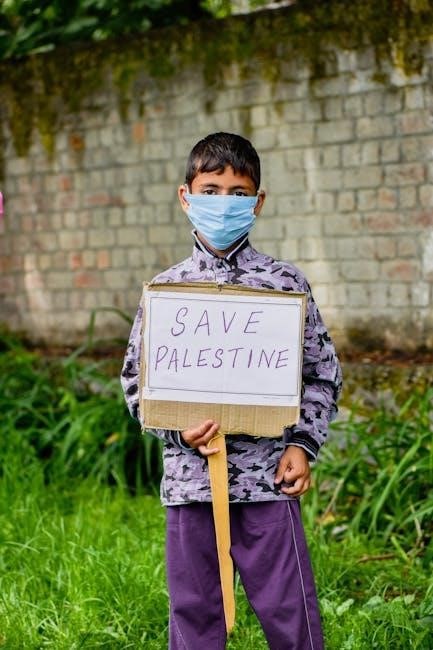
The Significance of the PDF Format
The PDF format enhances accessibility‚ ensuring Joe Sacco’s work reaches a global audience effortlessly. Its universal compatibility and high-quality visuals preserve the graphic novel’s integrity‚ making it a vital tool for widespread dissemination and engagement.
9.1. Accessibility and Distribution of the PDF Version
The PDF version of Palestine by Joe Sacco has significantly enhanced its accessibility‚ allowing readers worldwide to easily download and share the work. Its digital format ensures that the graphic novel reaches audiences who may not have access to physical copies‚ particularly in regions with limited distribution. The file’s portability and compatibility across devices make it a practical choice for widespread dissemination. This accessibility has played a crucial role in spreading Sacco’s powerful narrative‚ ensuring that the stories of Palestinians are seen and understood globally.
9.2. The Role of Digital Platforms in Promoting the Work
Digital platforms have been instrumental in promoting Palestine‚ enabling widespread sharing and discussion. Social media‚ online forums‚ and e-bookstores have facilitated easy access to the PDF‚ reaching global audiences. The digital format has also encouraged reader engagement‚ with online communities sharing insights and reflections. This digital presence has not only enhanced visibility but also fostered a broader dialogue about the Israeli-Palestinian conflict‚ ensuring Sacco’s work continues to resonate with readers worldwide.
9.3. The Future of Graphic Journalism in Digital Formats
The rise of digital formats promises a dynamic future for graphic journalism‚ as seen with Palestine. PDFs and e-books offer unparalleled accessibility‚ enabling readers to engage with complex narratives anywhere. Interactive elements‚ like zoom and search‚ enhance readability. This shift also allows younger audiences to discover works like Sacco’s‚ fostering a new generation of readers. However‚ the challenge lies in balancing innovation with the intimate‚ tactile experience of print. Digital adaptation ensures graphic journalism remains relevant in an increasingly virtual world.
Palestine by Joe Sacco remains a groundbreaking work‚ offering profound insights into the Israeli-Palestinian conflict. Its digital format ensures accessibility‚ preserving its legacy for future generations to reflect and learn.
10.1. The Lasting Legacy of “Palestine” by Joe Sacco
Joe Sacco’s Palestine has left an indelible mark on graphic journalism‚ offering a raw‚ unfiltered portrayal of life under occupation. Its legacy lies in its ability to humanize the Palestinian experience‚ transcending mere reportage. The PDF format has ensured its accessibility‚ allowing global audiences to engage with its powerful narrative. Sacco’s work continues to inspire journalists and artists‚ cementing its place as a seminal work in understanding the Israeli-Palestinian conflict. Its impact endures‚ fostering empathy and dialogue on a deeply contentious issue.
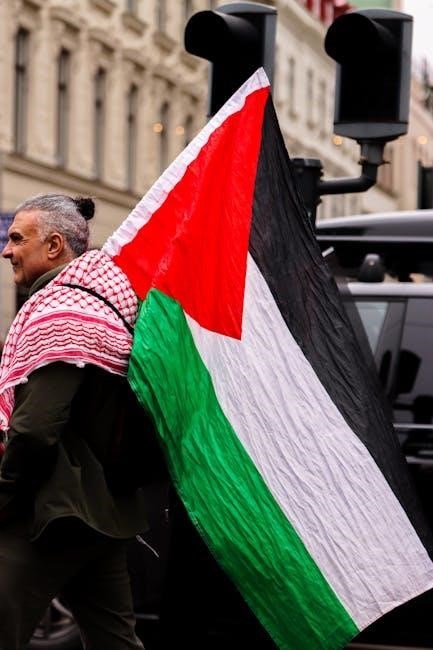
10.2. The Importance of Continuing the Dialogue
Continuing the dialogue sparked by Palestine is crucial for fostering understanding and empathy. Sacco’s work humanizes the conflict‚ offering insights that transcend traditional journalism. By engaging with these narratives‚ readers can gain a deeper appreciation of the complexities involved. Ongoing discussions encourage awareness and promote peace by keeping the conversation alive. The PDF format’s accessibility ensures that these stories reach a broader audience‚ facilitating dialogue across borders and cultures. Readers play a vital role in sharing and reflecting on these narratives‚ contributing to a more informed global community.
10.3. The Role of Readers in Supporting Such Works
Readers play a vital role in supporting works like Palestine by engaging deeply with the content and sharing it widely. Their active participation helps amplify marginalized voices and ensures the stories remain relevant. Financial support‚ through purchases or donations‚ enables creators to continue their work. The PDF format’s accessibility makes it easier for readers to share and access the work globally‚ fostering a broader dialogue. By supporting such works‚ readers contribute to a more informed and empathetic community‚ encouraging further storytelling and awareness‚ and promoting social change.
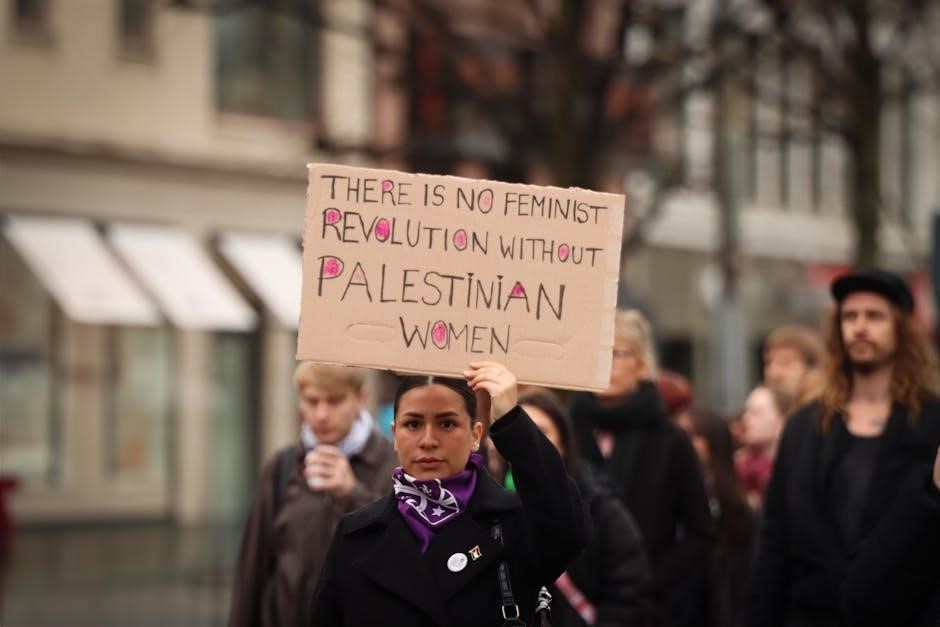
Additional Resources and Further Reading
Explore Joe Sacco’s Footnotes in Gaza for deeper insights into Palestinian experiences. Check out academic articles on graphic journalism and visit platforms like Cartoon Movement for related works.
11.1. Recommended Books and Articles on the Topic
For further exploration‚ read Joe Sacco’s Footnotes in Gaza and Safe Area Goražde for similar thematic depth. Explore articles by scholars like Edward Said and Rashid Khalidi for historical context. Check out graphic journalism analyses in Cartoon Studies and Visual Culture journals. Lila Abu-Lughod’s Return to Palestine offers a personal narrative perspective. Academic essays on Palestine’s representation in media are also available in Cultural Studies and Middle East Report.
11.2. Online Platforms for Graphic Journalism

Explore platforms like The Nib and Cartoon Movement for graphic journalism. These sites feature Joe Sacco’s work and similar pieces‚ offering critical insights and visual narratives. Digital archives like MCA Chicago also host Sacco’s collections. For academic discussions‚ visit JSTOR and Taylor & Francis. Online forums and communities‚ such as Reddit’s Graphic Novels‚ foster dialogue and sharing of graphic journalism.
11.3. Academic Studies on Joe Sacco’s Work
Scholars have extensively analyzed Joe Sacco’s works‚ particularly Palestine‚ for its unique blend of journalism and art. Academic journals like ImageTexT and The Cartoon Studies Journal feature studies on his narrative techniques and political commentary. Universities worldwide‚ including the University of Florida and Duke University‚ incorporate his work into courses on graphic journalism and conflict studies. These studies highlight how Sacco’s visuals and storytelling bridge personal and political narratives.
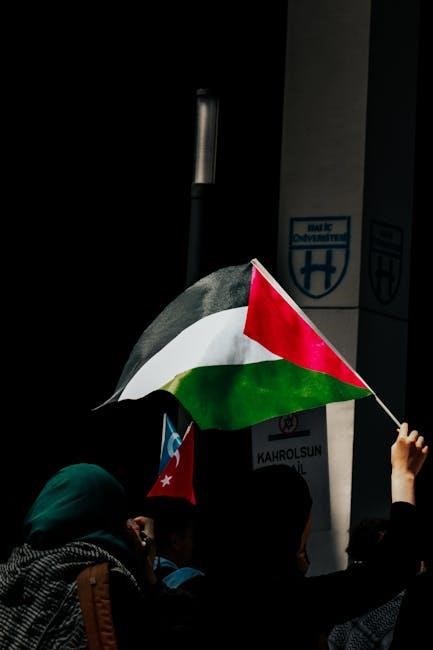
Final Remarks on the PDF Version
The PDF version of Palestine ensures timeless accessibility‚ preserving Sacco’s graphic journalism for digital audiences. Its portability and clarity make it a vital resource for understanding the conflict.
12;1. The Convenience of the PDF Format
The PDF version of Palestine offers unparalleled convenience‚ allowing readers to access Joe Sacco’s powerful narrative and visuals on various devices. Its digital format ensures portability‚ enabling easy storage and sharing without compromising quality. The PDF retains the graphic novel’s visual integrity‚ making it an ideal choice for academic and personal use. This accessibility has broadened the reach of Sacco’s work‚ ensuring his critical commentary on the Israeli-Palestinian conflict remains widely available and engaging for global audiences.
12.2. The Challenges of Digital Publishing
While the PDF format enhances accessibility‚ it also poses challenges‚ such as piracy and copyright infringement risks. Digital publishing can lead to unauthorized sharing‚ potentially reducing sales and undermining the creator’s revenue. Additionally‚ the visual-heavy nature of Palestine may not render optimally on all devices‚ affecting the reader’s experience. These issues highlight the tension between convenience and preservation of artistic integrity in the digital age.
12.3. The Importance of Preserving the Work Digitally
Preserving Palestine digitally ensures its longevity and accessibility for future generations. The PDF format allows the graphic novel to reach a global audience‚ transcending physical boundaries. It also enables archiving‚ safeguarding Joe Sacco’s work against loss or degradation. Digital preservation fosters educational opportunities‚ making the book a valuable resource for scholars and readers alike. By maintaining its digital presence‚ the stories and testimonies within remain relevant‚ ensuring the Palestinian experience continues to resonate in collective memory.




